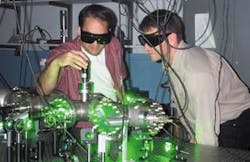University of Nebraska (UNL; Lincoln, NE) researchers have reported what is believed to be the first observation of coherent interference patterns arising from the Kapitza-Dirac effect—the diffraction of a beam of particles, electrons in particular, by a standing wave of light. This achievement may lead to measuring devices that are thousands of times more accurate than those in use today, according to the researchers, and could have interesting consequences for studies of quantum chaos and the design of electron interferometers.
The Kapitza-Dirac effect was predicted in 1933 by a pair of future Nobel Prize winners, Russian Peter Kapitza (1894-1984) and Englishman P. A. M. Dirac (1902-1984), but the technology needed to demonstrate it didn't exist at the time, and wouldn't until well after the invention of the laser in 1960.
A basic physics experiment that illustrates the wave nature of light involves placing a screen with two slits in it at a distance from a point source of light, and placing a second screen beyond the first. Instead of two bars of light appearing on the second screen directly in line with the light and the slits, multiple light bars appear across the second screen because the slits diffract the light and the bars mark the regions on the screen where the light from the slits constructively interferes.
In a slightly modified version of that experiment, Herman Batelaan, an associate professor in UNL's physics and astronomy department, and his research team including Daniel Freimund and Kayvan Aflatooni, replaced a light beam with an electron beam that crosses two counterpropagating laser beams that form the standing wave light grating. To reach sufficiently high laser intensities, an Nd:YAG-laser with 10-ns pulses and an energy of 0.2 J/pulse focused to a 125-µm-diameter beam waist was substituted in place of a screen with slits. The research team discovered that the electrons were indeed diffracted by the laser, just as Kapitza and Dirac had predicted 68 years earlier.
"The average wavelength in a laser beam is 1 µm. The wavelength of this electron wave is 10,000 times smaller," explained Batelaan. "If you use the Kapitza-Dirac effect multiple times, you can make an interferometer—although we haven't done that yet. We're trying to figure out what the implications are for use in rotation sensors and electromagnetic field sensors."
The observation of the Kapitza-Dirac effect should open the door to various new experiments, according to Batelaan. Since the diffracted electron beams are coherent with each other, the Kapitza-Dirac Effect constitutes a coherent-beam splitter. Just as for atoms, the combination of three such beamsplitters can be used to construct a Mach-Zehnder interferometer. In addition, when compared to biprism electron interferometers, the researchers report that this new type of electron interferometer would operate at very low electron energies and seems to be well-suited to study forward electron-atom scattering phase shifts.
The research team believes that the study of the interaction of free electrons with laser light can probably be extended from quantum mechanics to include spin, chaotic behavior, and relativistic mechanics.
REFERENCE
- D. L. Freimund et al., Nature 413, 142 (Sept. 13, 2001).

